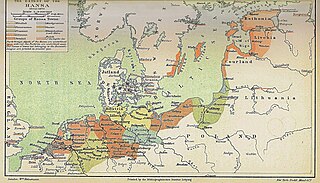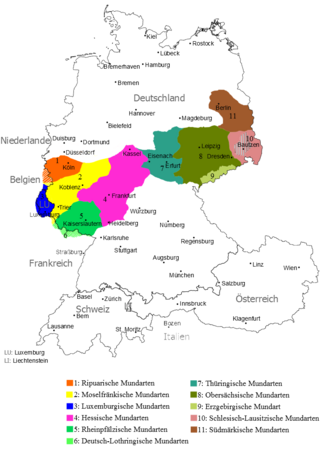
German is a West Germanic language in the Indo-European language family, mainly spoken in Western and Central Europe. It is the most widely spoken and official or co-official language in Germany, Austria, Switzerland, Liechtenstein, and the Italian province of South Tyrol. It is also an official language of Luxembourg and Belgium, as well as a recognized national language in Namibia. There further exist notable German-speaking communities in France (Alsace), the Czech Republic, Poland, Slovakia, Denmark, Romania and Hungary (Sopron).
The High German languages, or simply High German – not to be confused with Standard High German which is commonly also called "High German" – comprise the varieties of German spoken south of the Benrath and Uerdingen isoglosses in central and southern Germany, Austria, Liechtenstein, Switzerland, Luxembourg, and eastern Belgium, as well as in neighbouring portions of France, Italy, the Czech Republic (Bohemia), and Poland. They are also spoken in diasporas in Romania, Russia, Canada, the United States, Brazil, Argentina, Mexico, Chile, and Namibia.

Pomerania is a historical region on the southern shore of the Baltic Sea in Central Europe, split between Poland and Germany. The central and eastern part belongs to the West Pomeranian, Pomeranian and Kuyavian-Pomeranian voivodeships of Poland, while the western part belongs to the German states of Mecklenburg-Western Pomerania and Brandenburg.
Standard High German (SHG), less precisely Standard German or High German, is the umbrella term for the standardized varieties of the German language, which are used in formal contexts and for communication between different dialect areas. German is a pluricentric Dachsprache with currently three codified specific national varieties: German Standard German, Austrian Standard German and Swiss Standard German.

Middle Low German is a developmental stage of Low German. It developed from the Old Saxon language in the Middle Ages and has been documented in writing since about 1225/34 (Sachsenspiegel). During the Hanseatic period, Middle Low German was the leading written language in the north of Central Europe and served as a lingua franca in the northern half of Europe. It was used parallel to medieval Latin also for purposes of diplomacy and for deeds.

East Low German is a group of Low German dialects spoken in north-eastern Germany as well as by minorities in northern Poland. Together with West Low German dialects, it forms a dialect continuum of the Low German language. Before 1945, the dialect was spoken along the entire then-German-settled Baltic Coast from Mecklenburg, through Pomerania, West Prussia into certain villages of the East Prussian Klaipėda Region.

Low German is a West Germanic language spoken mainly in Northern Germany and the northeastern Netherlands. The dialect of Plautdietsch is also spoken in the Russian Mennonite diaspora worldwide.

Limburgish, also called Limburgan, Limburgian, or Limburgic, is a West Germanic language spoken in Dutch Limburg, Belgian Limburg, and neighbouring regions of Germany.

Berlin German, or Berlin dialect, is the regiolect spoken in the city of Berlin as well as its surrounding metropolitan area. It originates from a Brandenburgisch dialect. However, several phrases in Berlin German are typical of and unique to the city, indicating the manifold origins of immigrants, such as the Huguenots from France.

Hessian is a West Central German group of dialects of the German language in the central German state of Hesse. The dialect most similar to Hessian is Palatinate German of the Rhine Franconian sub-family. However, the Hessian dialects have some features which set them somewhat apart from other West-Central German dialects.

Upper Saxon is an East Central German dialect spoken in much of the modern German state of Saxony and in adjacent parts of southeastern Saxony-Anhalt and eastern Thuringia. As of the early 21st century, it is mostly extinct and a new regiolect has emerged instead. Though colloquially called "Saxon", it is not to be confused with the Low Saxon dialect group in Northern Germany. Upper Saxon is closely linked to the Thuringian dialect spoken in the adjacent areas to the west.

Central German or Middle German is a group of High German languages spoken from the Rhineland in the west to the former eastern territories of Germany.

The Lusatian dialects are East Central German dialects spoken in southern Brandenburg and eastern Saxony. The name "Lusatian" derives from the term Lusatia, meaning the dialects of Lusatia. They are most closely related to Silesian German.

East Central German or East Middle German is the eastern Central German language and is part of High German. Present-day Standard German as a High German variant, has actually developed from a compromise of East Central and East Franconian German. East Central German dialects are mainly spoken in Central Germany and parts of Brandenburg, and were formerly also spoken in Silesia and Bohemia.
Northern Germany is a linguistic, geographic, socio-cultural and historic region in the northern part of Germany which includes the coastal states of Schleswig-Holstein, Mecklenburg-Vorpommern and Lower Saxony and the two city-states Hamburg and Bremen. It contrasts with Southern Germany, Western Germany and Eastern Germany.
Starting in the 12th century, the Margraviate, later Electorate, of Brandenburg was in conflict with the neighboring Duchy of Pomerania over frontier territories claimed by them both, and over the status of the Pomeranian duchy, which Brandenburg claimed as a fief, whereas Pomerania claimed Imperial immediacy. The conflict frequently turned into open war, and despite occasional success, none of the parties prevailed permanently until the House of Pomerania died out in 1637. Brandenburg would by then have naturally have prevailed, but this was hindered by the contemporary Swedish occupation of Pomerania, and the conflict continued between Sweden and Brandenburg-Prussia until 1815, when Prussia incorporated Swedish Pomerania into her Province of Pomerania.

Schmargendorf is a south-western locality (Ortsteil) of Berlin in the district (Bezirk) of Charlottenburg-Wilmersdorf. Until 2001 it was part of the former district of Wilmersdorf.
Northern Low German is a variety of Low German in Germany, distinguished from Southern Low German.










